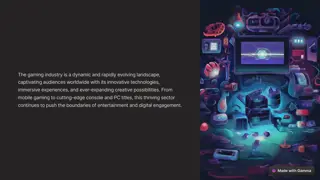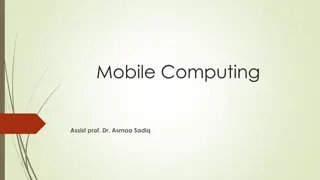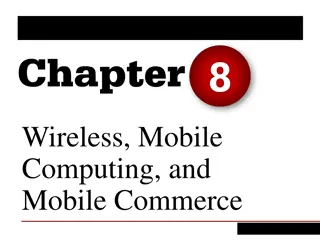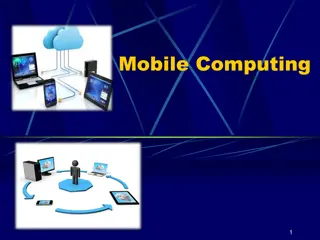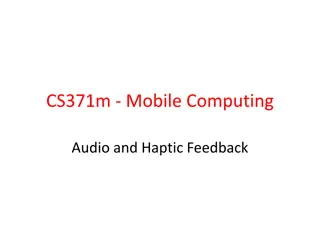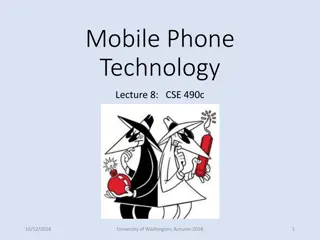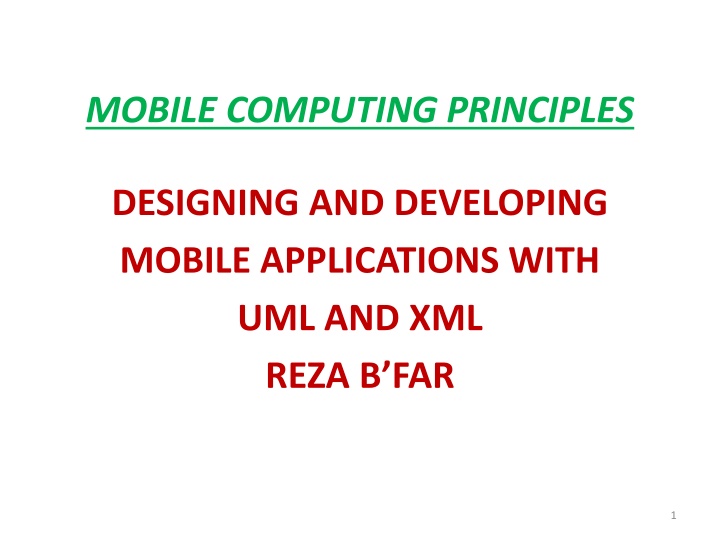
Introduction to Mobile Computing Systems
Mobile computing systems encompass a range of portable devices like laptops, PDAs, and mobile phones, offering wireless connectivity and unique functionalities suited for on-the-go use. Explore the evolution of mobile applications, development techniques, and basic technologies enabling developers to create impactful mobile applications seamlessly.
Download Presentation

Please find below an Image/Link to download the presentation.
The content on the website is provided AS IS for your information and personal use only. It may not be sold, licensed, or shared on other websites without obtaining consent from the author. If you encounter any issues during the download, it is possible that the publisher has removed the file from their server.
You are allowed to download the files provided on this website for personal or commercial use, subject to the condition that they are used lawfully. All files are the property of their respective owners.
The content on the website is provided AS IS for your information and personal use only. It may not be sold, licensed, or shared on other websites without obtaining consent from the author.
E N D
Presentation Transcript
MOBILE COMPUTING PRINCIPLES DESIGNING AND DEVELOPING MOBILE APPLICATIONS WITH UML AND XML REZA B FAR 1
Introduction to Mobile Computing 1.1 Introduction 1.2 Added Dimensions of Mobile Computing 1.3 Condition of the Mobile 1.4 Architecture of Mobile Software Applications Android Development- the basics 2
Introduction Mobile computing systems are computing systems that may be easily moved physically and whose computing capabilities may be used while they are being moved. Examples are laptops, personal digital assistants (PDAs), and mobile phones. Among the distinguishing aspects of mobile computing systems are their prevalent wireless network connectivity, their small size, the mobile nature of their use, their power sources, and their functionalities that are particularly suited to the mobile user. Because of these features, mobile computing applications are inherently different than applications written for use on stationary computing systems. 3
Introduction Abacus 500 B.C. Electricity . 1800's First Computers .. . Mid 1900's Networking 1960 1970 Satellites 1970 1980 Cellular Technologies 1980 2000 In the next section , we will look at those things that make the functional nature of mobile applications different than their stationary counterparts, take a survey of various development techniques that can be used to address these differences, and look at various basic technologies that allow us, as software developers, to create meaningful mobile applications in an extensible, flexible, and scalable manner. 4
Introduction greatest Because communications originated in the military, it is no surprise that one of the first applications of wireless communication for mobile computing systems was in displaying terrain maps of the battlefield. From this, the global positioning system (GPS) evolved so that soldiers could know their locations at any given time. Portable military computers were provided to provide calculations, graphics, and other data in the field of battle. In recent years, wireless telephony has become the major provider of a revenue stream that is being invested into improving the infrastructure to support higher bandwidth data communications. the advances in mobile 5
Wireless Mobile Recently, computer networks have evolved by leaps and bounds. These networks have begun to fundamentally change the way we live. Today, it is difficult to imagine computing without network connectivity. Networking and distributed computing are two of the largest segments that are the focus of current efforts in computing. Networks and computing devices are becoming increasingly blended together. Most mobile computing systems today, through wired or wireless connections, can connect to the network. . Because of the nature of mobile computing systems, network connectivity of mobile systems is increasingly through wireless communication systems rather than wired ones. And this is quickly becoming somewhat of a nonmandatory distinguishing element between mobile and stationary systems. 6
Wireless Mobile There are four pieces to the mobile problem: the mobile user, the mobile device, the mobile application, and the mobile network. We will distinguish the mobile user from the stationary user by what we will call the mobile condition The set of properties that distinguishes the mobile user from the user of a typical, stationary computing system. We will wrap the differences between typical devices, applications, and networks with mobile devices, applications, and networks into a set of properties that we will call the dimensions of mobility: the set of propertiesthat distinguishes the mobile computing system from the stationary computingsystem. 7
ADDED DIMENSIONS OF MOBILE COMPUTING The dimensions of mobility (Figure 1.3) are as follows: 1. location awareness, 2. network connectivity quality of service (QOS), 3. limited device capabilities (particularly storage and CPU), 4. limited power supply, 5. support for a wide variety of user interfaces, 6. platform proliferation, and 7. active transactions 8
Location Location : There are two general categories: localization and location sensitivity. Localizationis the mere ability of the architecture of the mobile application to accommodate logic that allows the selection of different business logic, level of work flow, and interfaces based on a given set of location information commonly referred to as locales. Localization is not exclusive to mobile applications but takes a much more prominent role in mobile applications. Localization is often required in stationary applications where users at different geographical locations access a centralized system. For example, some point-of-sale (POS) systems and e-commerce Web sites are able to take into account the different taxation rules depending on the locale of the sale and the location of the purchase. Whereas localization is something that stationary applications can have, location sensitivity s something fairly exclusive to mobile applications. 10
Location 11
Location The most well known location sensing system today is GPS. GPS-enabled devices can obtain latitude and longitude with accuracy of about 1 5 m. GPS has its roots in the military; until recently, the military placed restrictions on the accuracy of GPS available for public use. Most of these restrictions have now been lifted. GPS devices use triangulation techniques by triangulating data points from the satellite constellation that covers the entire surface of the earth. If a device does not have GPS capabilities but uses a cellular network for wireless connectivity, signal strength and triangulation or other methods can be used to come up with some approximate location information, depending on the cellular network. 12
Location The most well known location sensing system today is GPS. GPS-enabled devices can obtain latitude and longitude with accuracy of about 1 5 m. GPS has its roots in the military; until recently, the military placed restrictions on the accuracy of GPS available for public use. Most of these restrictions have now been lifted. GPS devices use triangulation techniques by triangulating data points from the satellite constellation that covers the entire surface of the earth. If a device does not have GPS capabilities but uses a cellular network for wireless connectivity, signal strength and triangulation or other methods can be used to come up with some approximate location information, depending on the cellular network. 13
Quality of Service Whether wired or wireless connectivity is used, mobility means loss of network connectivity reliability. Moving from one physical location to another creates physical barriers that nearly guarantee some disconnected time from the network. If a mobile application is used on a wired mobile system, the mobile system must be disconnected between the times when it is connected to the wired docking ports to be moved. Of course, it is always a question whether a docking port is available when required let alone the quality and type of the available network connectivity at that docking port. In the case of wireless network connectivity, physical conditions can significantly affect the quality of service (QOS). For example, bad weather, solar flares, and a variety of other climate- related conditions can negatively affect the (QOS). 14
Quality of Service When it comes to taking into account the QOS in most applications, certain functionality is expected of most mobile applications. For example, almost all mobile applications should know how to stop working when the application suddenly disconnects from the network and then resume working when it connects again. Other functionality may be desired but not required. For example, often QOS data are measured and provided by the network operator. For example, the real-time bandwidth available may be part of the data provided and refreshed on some time interval. Such data can be utilized to design applications that dynamically adapt their features and functionality to the available bandwidth. 15
Limited Device Storage and CPU No one wants to carry around a large device, so most useful mobile devices are small. This physical size limitation imposes boundaries on volatile storage, nonvolatile storage, and CPU on mobile devices. Though solid-state engineers are working on putting more and more processing power and storage into smaller and smaller physical volumes, nevertheless, as most mobile applications today are very rudimentary, there will be more and more that we will want to do with them. Today s mobile applications are resource-starved. So, although the designers of modern applications designed to run on personal computers (PCs) and servers continue to care less and less about system resources such as memory and processing power, it is a sure bet that memory limitations will be around for a long time for mobile applications because when it comes to mobile systems and devices, smaller is nearly always better 16
Limited Device Storage and CPU Limitations of storage and CPU of mobile devices put yet another constraint on how we develop mobile applications. For example, a mobile calendaring application may store some of its data on another node on the network (a PC, server, etc.). The contacts stored on the device may be available at any time. However, the contact information that exists only on the network is not available while the device is disconnected from the network. But, because the amount of data that can be stored on each type of device varies depending on the device type, it is not possible to allocate this storage space statically. Also, some information may be used more frequently than others; for example, the two weeks surrounding the current time may be accessed more frequently in the calendar application or there may be some contacts that are used more frequently. Mobile applications must be designed to optimize the use of data storage and processing power of the device in terms of the application use by the user. 17
Limited Power Supply We have already seen that the size constraints of the devices limit their storage capabilities and that their physical mobility affects network connectivity. For the same set of reasons that wireless is the predominant method of network connectivity for mobile devices, batteries are the primary power source for mobile devices. Batteries are improving every day and it is tough to find environments where suitable AC power is not available. Yet, often the user is constantly moving and devices are consuming more and more power with processors that have more and more transistors packed into them. The desirability of using batteries instead of an AC power source combined with the size constraints creates yet another constraint, namely a limited power supply. This constraint must be balanced with the processing power, storage, and size constraints; the battery is typically the largest single source of weight in the mobile. The power supply has a direct or an indirect effect on everything in a mobile device . 18
Extra DIMENSIONS OF MOBILE COMPUTING Varying User Interfaces: Stationary users use nonmobile applications while working on a PC or a similar device. The keyboard, mouse, and monitor have proved to be fairly efficient user interfaces for such applications. This is not at all true for mobile applications. Platform Proliferation: Because mobile devices are small and there is much less hardware in them than in a PC, they are typically less costly to assemble for a manufacturer. This means that more manufacturers can compete in producing these devices. Active Transactions: Most of today s stationary applications have a restriction that can reduce the benefits of a mobile application system enormously: The user of the system must initiate all interactions with the system. We call such systems passive systems because they are in a passive state, waiting for some external signal from the user to tell them to start doing some particular thing. 19
ARCHITECTURE OF MOBILE SOFTWARE APPLICATIONS The first step in building a software application, after the process of gathering requirements, is to lay down a high- level plan of what the application will be like when it is finished. Mobile applications, like any other software application, require such a high-level plan . We call this high-level plan of the mobile application a mobile software architecture. Our approach to architecture in this text will be bottom up: we will introduce a variety of design patterns, application architectures, and processes with each addressing some specific problem with mobile applications (next Figure). 20

